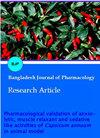孟加拉国药品宣传文献综述
IF 0.9
4区 医学
Q4 PHARMACOLOGY & PHARMACY
引用次数: 4
摘要
本研究旨在评价药品宣传文献的质量。88.2%的宣传文献中提到了适应症,其中不到一半(40.0%、33.9%和38.9%)分别包含副作用、注意事项和禁忌症。在提供的信息中,与BDNF/BNF匹配的比例分别为67.3%、16.5%、19.5%和24.0%。科学文章(73.3%)被引用最多,其次是商业在线来源(15.5%)、档案数据(4.2%)、监管机构批准数据(2.9%)、产品专著(2.7%)和教科书/参考书(1.6%)。这些引用的参考文献中只有一半(50.2%)是可检索的,没有“档案数据”可检索。尽管大多数(73.2%)的宣传声明是真实的,但分别有13.7%、5.9%、4.6%和2.6%被认定为虚假、夸大、模棱两可和有争议。这一宣传文献质量的披露可能会让政策制定者大开眼界。更重要的是,这可能会在解读药物宣传文献时引起医生的警觉。本文章由计算机程序翻译,如有差异,请以英文原文为准。
Snapshot of the pharmaceutical promotional literature of Bangladesh: A critical review
The present research was conducted to evaluate the quality of pharmaceutical promotional literature. Indications was mentioned in 88.2% promotional literature and less than half (40.0, 33.9 and 38.9%) of these contains side effects, precautions and contraindications respectively. Among the provided information 67.3%, 16.5%, 19.5% and 24.0% matched with the BDNF/BNF respectively. Scientific articles (73.3%) were cited most followed by commercial online sources (15.5%), data on file (4.2%), regulatory body approval data (2.9%), product monograph (2.7%) and textbook/reference book (1.6%). Only half (50.2%) of these cited references were retrievable and no ‘data on file’ could be retrieved. Though most (73.2%) of the promotional claims were true, 13.7, 5.9, 4.6 and 2.6% were identified as false, exaggerated, ambiguous and controversial respectively. This revelation about the quality of promotional literature might an eye opener for the policy makers. More importantly, this may bring alertness among the physicians during interpretation of pharmaceutical promotion literature.
求助全文
通过发布文献求助,成功后即可免费获取论文全文。
去求助
来源期刊

Bangladesh Journal of Pharmacology
PHARMACOLOGY & PHARMACY-
CiteScore
1.50
自引率
18.80%
发文量
4
审稿时长
>12 weeks
期刊介绍:
Bangladesh Journal of Pharmacology (Bangladesh J Pharmacol) is an open access, video component, peer-reviewed journal of the Bangladesh Pharmacological Society (BDPS).
A scholarly publication is defined ''open access'' when there are no financial, legal or technical barriers to accessing it. Anyone can read, download, copy, distribute, print or use it in educational purpose within the legal agreements.
Peer review of a manuscript means the evaluation of research work by one or more people with similar competences. It can be open or blind. We do the single-blind peer review.
Our readers want to know the methodology used by the researchers which is very important to get the results. The video clip of one of the methodologies is prepared by the authors and submit it to publish.
 求助内容:
求助内容: 应助结果提醒方式:
应助结果提醒方式:


